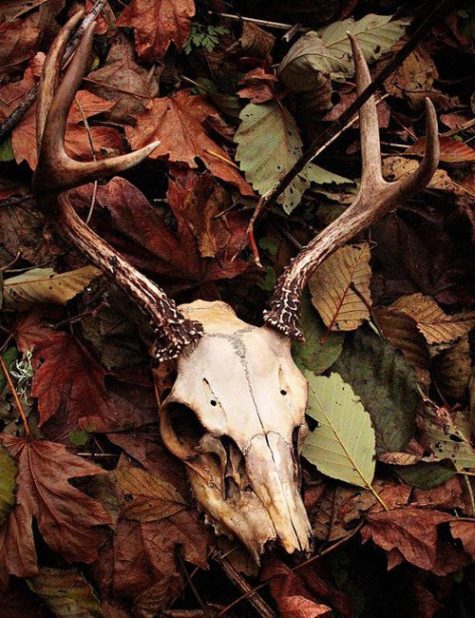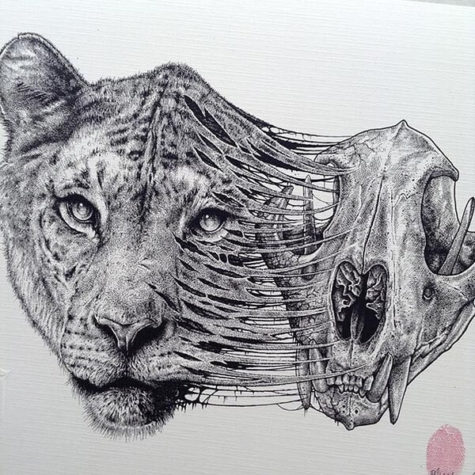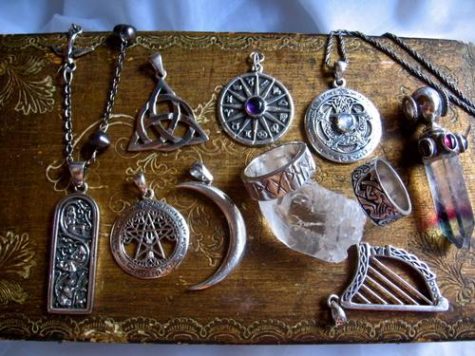Fetishes
As well as giving structure to the body; bones survive for a long time after death, and so are imbued with magickal properties. Both human and animal bones could be, and were employed in spells and healing charms, and also in divination.
Bones are a type of fetish. A fetish is “an object regarded with awe as being the embodiment or habitation of a potent spirit or as having magical potency (source)”. The word fetish originates from the French fétiche which stems from the Portuguese word feitiço meaning “charm” or “sorcery”. Feathers, bones, crystals, and stones are all types of fetishes. Skulls and bones have an appeal to witches who perform spirit work and are a necessary and simple way to connect with spirits of the dead and of animals.
Working with bones is not just for necromancers and black magicians. Practitioners who work with bones are a wide range of healers, diviners, shapeshifters, rootworkers, witches, shamans, druids, and pagans.
Over two thousand year ago, in China, bones were heated up and the resulting cracks interpreted as indicating a prediction. Bones as predictive devices were used in other ways, too. For example, bones of small animals were collected in a ritual way, and thrown upon the ground in the act of “casting the bones,” a term reference still in use for other divinatory methods, such as rune stones.
In Britain, divination by the blade-bone of a sheep was formerly well known. In Africa, thieves were detected, lost goods found, and problems solved by the ceremony of “Throwing The Bones.” Different kinds, usually those of domestic or wild animals, are used to represent individuals, or spirits, or the forces of nature, and are thrown like dice. The answers to the question being read from how and where they fall.
- You can read more about various methods of bone divination here: Throwing The Bones
Animal bones are used in witchcraft and folk magic to commune and work with animal spirits as familiar, guides, and protectors. Like human bones, the bones of animals can be also be used to ground a spirit animal in this realm. Bones act as a spirit vessel for animal familiars to dwell in when you work with them. This doesn’t mean that the spirit lives in the bone(s) all the time, but instead it is their home when you call upon them.
Animal bones and skulls can be placed on an altar or carried in a medicine or crane bag to work with them outdoors or on the move. Animal bones can be used to call upon mythological creatures as well. To do this you need only to combine bones from the different animals that make up the creatures. For example, bind together parts from an eagle and lion to summon a griffon or combine snake, lizard, and the bones or feathers of a bird of prey to summon a dragon.
Animal bones can be incorporated into ritual jewelry for direct contact and easier communion with the spirits the bones belong to. Ritual jewelry using bones is the most practical and direct way of bringing your animal familiars into rituals and spellwork.
If you only have very small bones or a delicate insect to work with than you can place the parts in a glass vial and either use it as a vessel on your altar or attach a chain or leather thong to it to wear around your neck. By wearing animal bones you can take on the attributes and powers of the animal they belong to such as fox teeth for cunning, owl bones for seeing in the dark, or snake bones for the ability to renew and change your life.
Bones can also confer an animal’s magical abilities. Many animals are “shamanic” in nature enabling the practitioner to whom they are familiar to adopt their ability to travel between worlds. Such creatures known to travel between the realms of earth, sea, and sky or have extraordinary powers of transformation include frogs, toads, snakes, all birds (especially water fowl), alligators, crocodiles, turtles, beavers, otters, dragonflies, spiders, beetles, butterflies, cicadas, and more.
Animal bones can be used to craft ritual tools. Many traditional rattles are made using skulls, turtle shells, or little bones tied closely together for the sound of their rattling against one another. Bones can also be tied to staffs or stangs, wands, or even sewn onto ritual robes.
Animal bones, especially chicken and other bird bones, are used for traditional divination methods in many cultures. This can also be incorporated into European practice by carving Futhark or Ogham runes onto animal bones or using slices of deer antler instead of the usual materials of wood and stone.
Among the Australian aborigines, death spells are cast by “singing magic” into a bone and pointing it in the direction of the victim, who then pines away and dies.
A charm against cramping was to carry a knucklebone, or the patella of a man or a sheep.
Those afflicted with headaches could find relief by driving a nail into a dead man’s skull, or by drying and powdering the moss found upon it and using it as snuff.
Bones, like blood and some of the organs of the body, were once thought to be centers of psychic power, and to be the vehicle or dwelling-place of the soul. Life and consciousness remained in them after the death of the original owner, and it was therefore very dangerous to disturb them when they lay in the tomb.
Misfortune, or even death, inevitably followed such an act, which was forbidden alike by reverence for the dead and superstitious fears of their vengeance. Nevertheless, this widespread and strongly held belief did not prevent the quite frequent theft of bones from churchyards and prehistoric burial grounds for use in magick and witchcraft.
Symbolically, bones carry the essence of the creature that they were once a part of, and there’s a curious but relatively common belief that somehow or other an intact set of bones can be remade into a live body This idea is seen in fairy tales, myths, and traditions from all over the world.
An example of this is the Lapp belief that the bones of a bear, if carefully preserved, will come back to life and the animal will allow itself to be hunted once again. Bear “burial” places have been found where the bones of the bear have been carefully reconstructed. These sites also show evidence of respectful funerary rites.
In a similar practice, the Plains Indians would bury the bones of the buffalo with due care and attention so that the animal would be able to come back to life.
Due to its size, the bone is one of the very last in the body to rot, along with the skull. For this reason – its longevity – the bone was used as a vessel during religious and magickal rites and rituals.
Because bones are such an important part of the body and because they are believed to hold the essence of their owner, the bones of saints are considered holy relics, imbued with magickal powers, and kept locked away in churches. They were believed to be so holy that devils and demons would keep well away, and if the bones were dipped into wine or water, the resulting liquid would be infused with mysterious powers including the ability to cure various ailments.
Information collected from various sources
What follows is a list of items and their uses as charms, fetishes, talismans, or amulets:
- Acorn: Attracts the opposite gender, increases income, divine powers, and prosperity.
- Akhet: Ancient Egyptian amulet representing the rising sun. It is held to give the wearer the vigor of the sun god Ra.
- Alligator Teeth: Protection from sorcery and danger.
- Animals: Any statue, symbol or image of an animal can be used as a talisman. The meanings will change accordingly to the type of animal, it’s meanings and any cultural significance surrounding them. This even includes fantasy or mythological animals as well.
- Ankh: An Egyptian amulet meaning life or soul. It symbolizes enduring life and grants the wearer one hundred thousand million years of life.
- Bell: An amulet used by primitive and Western people whose sound was intended to ward off the evil eye and dispel hostile spirits. In the Middle East bells were attached to the harness of horses and camels for the same purposes.
- Billiken: A good luck ornament in the shape of a human figure.
- Cat Whisker: Carrying a cat whisker in the glove box of the car protects against car theft, troubles, accidents and traffic tickets.
- Chai: A symbol of life. Usually made from gold or silver. It supposedly grants the wearer longevity.
- Coffin Nails: In was said that a ring made from three nails that had been used in a coffin and dug up in a churchyard would act as a charm against convulsions and fits of every kind.
- Crickets: As a talisman of good luck, the Chinese would capture a live cricket and keep it in a box made of weeping willow wood.
- Cross: Life and divine protection. The Christians believed it to be a supreme amulet against all forces of evil. The sign of the cross was thought to cure illness and drive off demons.
- Cylinder Seal: A seal cylindrical in shape made of clay, precious stones and limestone worn around the neck by the Sumerians and other ancient people as a signature to authenticate business agreements.
- Deities: Symbols and images of Gods, like animals will also have varying meanings depending on the God or Goddess used and the particular attribute wanted or needed.
- Dream Catchers: According to the Sioux, the legends speak to us of the Dream Catcher. It is believed that each carefully woven web will catch your dreams in the night air. Placed over the bed or centered in a window, the bad spirit dreams will become entangled in the new day. The good spirit dreams will always find their way through the center opening, and will gently float down the sacred feather to bless the dreamer with peaceful dreams. Note: If you buy or make your Dream Catcher, make sure the center hole is not covered by a stone or fetish as that traps all dreams.
- Eye of God: Amulet used to counteract the evil eye. Made of sticks and colored yarn by Huichol Indians of Mexico and attributed with power of protecting people, homes, and fields.
- Eye of Horus: Egyptian Eye of God made of gold, copper, silver, clay, faience, or wood and worn to acquire strength, vitality, and protection against the evil eye.
- Four Leaf Clover: Good luck amulet. The four leaves going clockwise from the left side of the stem represents fame, wealth, love, and health.
- Fox Tail: Good luck amulet attached to personal possessions. Primitive people believed that it endowed the owner with the cunning of the animal.
- Heart: An amulet worn by many people around the world. It’s a symbol of love and devotion. Ancient Egyptians thought the heart was the abode of the soul. In Europe a heard amulet was reputed to prevent heart disease.
- Hexagram: A figure of six lines forming a six pointed star. It is worn in many parts of the world as a protection against evil. A widely worn symbol of the Jewish faith called Morgen David, shield or, popularly, star of David.
- Horn of Plenty: A contemporary amulet symbolizing prosperity, modeled on the legendary cornucopia overflowing with flowers and fruit.
- Horseshoes: Nail a horseshoe above the door way leading into a home, keep it pointed upwards so as to keep the luck from running out.
- Knot: An amulet usually of knotted string or cord that was believed to hold the love of a sweetheart or ward off illness.
- Lizard Tail: In many species, as seen by geckos especially, the tail drops off when seized by a predator, allowing them to escape and a new tail grows to replace the old one. For this reason, lizard tails are regarded as good luck talismans.
- Magic Triangle: Cabbalistic amulet based on the belief that by reducing the size of an inscription, line by line, and evil spirit could be eased out of the sufferer.
- Mezuzah: Doorpost amulet designed to keep a house safe from evil spirits, demons, ghosts. and good fortune in travel. To assure good fortune it should be worn as a waxing, not a waning moon. That is, with the points to the left.
- Mirrors: The mirror is the quickest way to send back negativity or to absorb it. In ritual, cleanse, consecrate and empower the mirror for protection. Hang the mirror in a central place of the house where it will absorb the negative energy of the house. This is also the source of the term: “Break a mirror, you’ll have seven years bad luck” as the person who breaks the mirror, takes all the negative energy absorbed by the mirror into themselves.
- Moon: Amulet worn in ancient and modern times to bring success in love and good fortune in travel. To assure good fortune it should be worn as a waxing, not a waning moon. That is, with the points to the left.
- Nefer: An amulet worn by the Egyptians. It represents beauty and goodness. It probably is a form of the heart and windpipe, and was thought to bring youth and happiness. Very popular for making necklaces.
- Pennies: “See a penny, pick it up and all day long you’ll have good luck.” Popular to this is if the penny is heads up when found, it’s good luck. Tails it’s bad luck. To avert this, place the penny in your left shoe to counter the bad luck and give a day, 24 hours of good luck. Pennies placed in the left shoe were also a ward against the magicks of fairies, particularly the harmful ones.
- Pentagram: A five pointed star representing the five elements of air, fire, water, earth, and spirit. Also represents the figure of a human being. It is thought to protect the wearer from all kinds of evil spirits. Can also be used by magicians to control spirits. Should be worn with one point up.
- Porcupine Quills: Supposedly charms against the evil eye.
- Rings: Worn as amulets to treat illness, dispel forces of evil, keep lovers together, and prevent flight of the soul from the body.
- Scarab: A variety of beetle: image of beetle in clay, faience, precious stones, or other material. Acquire the strength and long life of the god of creation. Was also thought to speak up in the judgment room for a favorable verdict for their master.
- Sma: An amulet representing the shape of lungs. Was used by Egyptians to give breathing power to the dead by placing on their mummies.
- Star: Ward off evil or encourage good fortune.
- Sun: Said to bestow prosperity and friendship. Probably of Egyptian origin.
- Tassels: Tassels or Fringes, as used during the medieval ages and after have been used as protective devices, because they confuse and distract evil or negative entities.
- Turtle or tortoise: shaped charm provides courage, creativity, intelligence, spiritual protection, compassion, fertility, sexuality,and protection.
Authors Details: Unknown Source
Found at: spiritual.com.au





